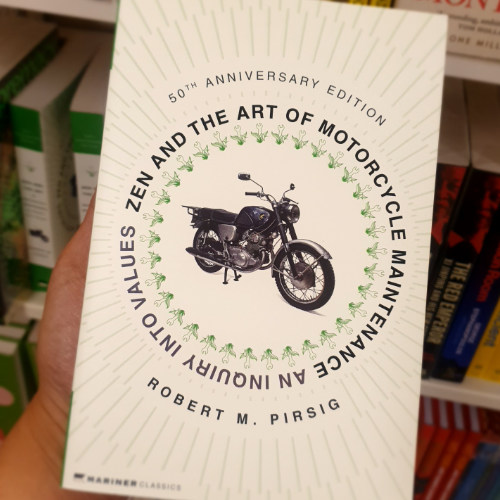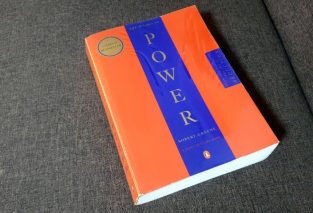A pilgrimage exploring the connection between quality, philosophy, and life. Through a motorcycle trip, it examines the balance of technology and humanity, finding meaning in everyday experiences and choices.

This philosophical journey blends a motorcycle road trip with reflections on life, exploring the meaning of quality, the balance between rationality and emotion, and the pursuit of personal fulfillment.
In Robert Pirsig’s Zen and the Art of Motorcycle Maintenance, the pursuit of a well-oiled life, both literally and figuratively, forms the philosophical and narrative backbone of this literary masterpiece.
A captivating odyssey that traverses the landscapes of both the physical world and the mind. And a unique blend of philosophical inquiry and narrative, where the motorcycle serves as a metaphor for the intricate balance between technology and human experience.
Truly a work that defies easy categorization, the book weaves together elements of a road trip, philosophy, and personal journey into a single, seamless narrative.
It explores the relationship between technology, quality, and the mind, leaving the reader to ponder the delicate balance between rational thought and lived experience.
What at first seems like an autobiography of a father and son on a motorcycle trip quickly deepens into an exploration of how we perceive and interact with the world around us.
From the very beginning, the author sets the stage with his dual narrative structure.
On one hand, we have the tangible journey of a father and son on a motorcycle trip across America, a pilgrimage through stunning vistas and small-town charm. On the other hand, we delve into his philosophical musings, which he refers to as “Chautauquas,” exploring the dichotomy between classical and romantic ways of understanding the world.
This duality forms the tone of the book, reflecting the tension between embracing technology and preserving humanistic values.
At its core, the book is about “quality,” a concept that the protagonist grapples with throughout the narrative.
His exploration of Quality is particularly compelling, as he challenges readers to redefine their understanding of value beyond conventional measures.
Quality, it is argued, is not easily quantifiable.
It exists at the intersection of intellect and intuition, where art meets science. This realization prompts an examination of how we interact with the world. Whether we engage with it mechanistically or aesthetically.
It’s an elusive term that has no clear definition in traditional philosophy, but the author insists that it is the very foundation of both our inner and outer worlds.
For him, quality transcends the divide between the classical and romantic modes of understanding.
The classical approach is analytic, rational, and detail-oriented. And sits in stark contrast to the romantic, which emphasizes intuition, emotion, and holistic experience.
The interplay of these perspectives is not a dichotomy for Pirsig, but rather a dance of harmony.
His exploration of motorcycle maintenance, something that requires both technical skill and a certain poetic awareness of the machine’s function, becomes a metaphor for how one might approach life itself.
Not just as a series of problems to be fixed, but as a holistic journey that requires engagement on multiple levels.
While the motorcycle serves as an ideal symbol for his philosophical inquiry, it is in his treatment of quality that the book takes on its deepest meaning.
The quality is not some abstract notion reserved for philosophers to debate in academic circles.
It is the very stuff of life.
It’s the moment when a motorcycle engine hums just right, or the moment when a human connection feels unspoken but profound. It is a tangible feeling that resists categorization, and in that resistance, the book encourages the reader to move beyond the constraints of intellectual frameworks and directly experience the world.
In essence, Pirsig is asking us not only to think about quality but to be quality in our actions, perceptions, and thoughts.
In some ways, the book’s philosophical journey mirrors its physical one.
Which is a road trip that unfolds alongside introspection and deep questioning.
Throughout the narrative, the lens of perception continually shifts between the personal and the abstract, at times blurring the lines between the narrator’s real experiences with his son, Chris, and the ideas he’s exploring.
The tension between these two narratives. The philosophical quest and the father-son dynamic, offers a poignant commentary on the internal and external struggles we all face as we try to reconcile our personal lives with the larger, often perplexing, questions of existence.
The book’s central paradox is this:
While one cannot simply “fix” life like a motorcycle, one can repair one’s perspective, one’s approach to life, by engaging more deeply with both its rational and emotional components.
Shortcomings
While the exploration of quality and the fusion of rational and romantic perspectives is undoubtedly profound, the book’s greatest shortcoming is perhaps its occasional intellectual abstraction.
It has a tendency to digress into dense philosophical discourse that can be difficult to follow, especially for readers unfamiliar with philosophical jargon.
While this is understandable given the depth of the ideas he is engaging with, it may alienate some readers who feel disconnected from the book’s more academic moments.
One could argue that by grounding these philosophical musings in concrete, everyday experiences, perhaps using more accessible language or breaking them down into smaller, digestible sections could make the ideas resonate more universally.
Sometimes, the intricate examination of metaphysics can also feel labyrinthine, leaving those unaccustomed to philosophical texts feeling adrift. A more structured guide or summary at key points could help readers navigate these complex ideas without losing sight of the overarching narrative.
Additionally, at times, the narrative shifts back and forth so rapidly between the personal and the intellectual that it can feel somewhat disjointed.
While this tension is part of the book’s charm, it occasionally disrupts the flow of the narrative, leaving the reader to wonder whether they are following a personal journey or a philosophical treatise.
In a sense, the book oscillates between the raw human experience and intellectual abstraction.
And while this may be intentional, it might frustrate some readers who prefer a more cohesive narrative arc.
Perhaps by incorporating a stronger sense of narrative continuity or more relatable human conflict, Pirsig could ensure that his philosophical ideas don’t overwhelm the personal story.
Biggest Takeaway
There is a profound insistence on integrating both the rational and the romantic ways of seeing.
It’s tempting in our fast-paced, hyper-analytical world to fall into the trap of believing that reason and technology alone will offer solutions to life’s problems.
Yet it reminds us time and again that to fully engage with life, to experience quality, we must recognize the beauty in the details while simultaneously allowing room for emotional resonance.
For example, when working on a motorcycle, one must not only understand its technical aspects, like the mechanics of how it functions. But also embrace the emotional satisfaction that comes with repairing and restoring it.
This nuanced approach calls for balance.
An understanding of the nuts and bolts, paired with a capacity to embrace the joy of discovery.
Some readers might also view it as an invitation to embrace life’s dualities.
To find harmony between technology and humanity, intellect and emotion, precision and art. By doing so, we can cultivate a deeper sense of “Quality” in our lives, where every moment becomes an opportunity for mindfulness and appreciation.
The book, in a sense, challenges readers to embrace both their analytical intellect and their capacity for wonder, encouraging a fuller, richer experience of life that transcends rigid binaries.
This is a landmark work in both literature and philosophy.
It reminds us that the act of “maintenance” is not just for machines, but for our minds and hearts as well.
Life, like a motorcycle, requires constant care and attention. Not just in the technical, problem-solving sense but in the way we approach our own well-being and the way we see the world.
We are, after all, our own machines, with gears and engines that need tuning.
In that sense, a big lesson is that by tuning ourselves, not just our intellect, but our emotional and spiritual selves, we can experience the world with greater clarity and joy.
If we focus too much on the mechanics, we miss the poetry of the ride. But if we neglect the mechanics altogether, we risk losing the ride’s essence.
Like a well-maintained motorcycle, life is best when its parts work together in harmony.
This is a timeless meditation on existence and understanding that challenges us to reconsider how we perceive value and engage with the world around us.
True enlightenment often lies not in grand revelations but in the quiet moments of clarity along the way.
Zen and the Art of Motorcycle Maintenance welcomes us to take a ride of our own, to fix what we can, and to embrace the mystery of the things we can’t. Tune into life’s subtle rhythms, finding beauty in both complexity and simplicity.



